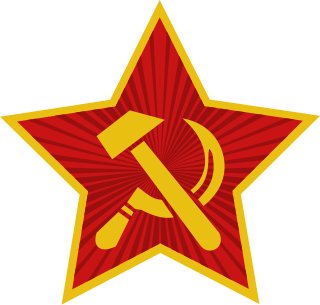
The Communist Party of Germany was a major far-left political party in the Weimar Republic during the interwar period, an underground resistance movement in Nazi Germany, and a minor party in West Germany during the postwar period until it was banned by the Federal Constitutional Court in 1956.

Friedrich Wilhelm Reinhold Pieck was a German communist politician who served as the chairman of the Socialist Unity Party from 1946 to 1950 and as president of the German Democratic Republic from 1949 to 1960.

Johann Heinrich Vogeler was a German painter, designer, and architect, associated with the Düsseldorf school of painting.

The Communist Workers' Party of Germany was an anti-parliamentarian and left communist party that was active in Germany during the time of the Weimar Republic. It was founded in April 1920 in Heidelberg as a split from the Communist Party of Germany (KPD). Originally the party remained a "sympathising member of Communist International." In 1922 the KAPD split into two factions, both of whom kept the name but are referred to as the KAPD Essen Faction and the KAPD Berlin Faction.

Hans Achim Litten was a German lawyer who represented opponents of the Nazis at important political trials between 1929 and 1932, defending the rights of workers during the Weimar Republic.
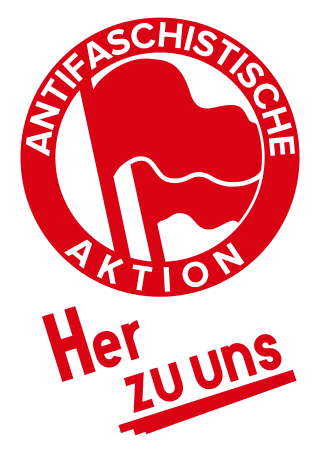
Antifaschistische Aktion was a militant anti-fascist organisation in the Weimar Republic started by members of the Communist Party of Germany (KPD) that existed from 1932 to 1933. It was primarily active as a KPD campaign during the July 1932 German federal election and the November 1932 German federal election and was described by the KPD as a "red united front under the leadership of the only anti-fascist party, the KPD."
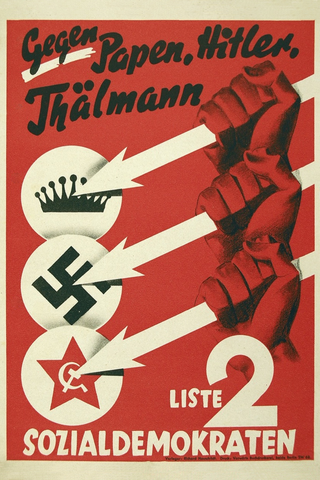
The Iron Front was a German paramilitary organization in the Weimar Republic which consisted of social democrats, trade unionists, and democratic socialists. Its main goal was to defend democratic socialism and liberal democracy against totalitarian ideologies on the far-right and far-left. The Iron Front chiefly opposed the Sturmabteilung (SA) wing of the Nazi Party and the Antifaschistische Aktion wing of the Communist Party of Germany. Formally independent, it was intimately associated with the Social Democratic Party of Germany (SPD). The Three Arrows, originally designed for the Iron Front, became a well-known social democratic symbol representing resistance against monarchism, Nazism, and Marxism-Leninism during the parliamentary elections in November 1932. The Three Arrows were later adopted by the SPD itself.
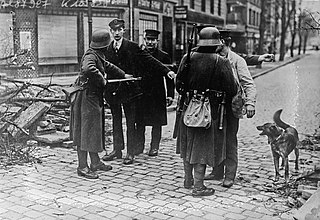
The Hamburg Uprising was a communist insurrection that occurred in Hamburg in Weimar Germany on 23 October 1923. A militant section of the Hamburg Communist Party of Germany launched an uprising as part of the so-called German October. Rebels stormed 24 police stations, 17 in Hamburg and seven in Schleswig-Holstein Province in Prussia, and established barricades around the city. The communist insurgency in Hamburg was futile, lacking support from the rest of Germany or from the Soviet Union, and disintegrated within a day. Around 100 people died during the Hamburg Uprising and the exact details of the event, as well as the assessment of its impact, remain controversial.

Franz Jacob was a German Resistance fighter against Nazism and a Communist politician.
The Cuno strikes were nationwide strikes in Germany against the government of Chancellor Wilhelm Cuno in August 1923. The wave of strikes demanded, eventually with success, the resignation of the Cuno government, which occurred on 12 August 1923, after only nine months. The strikes also buoyed the hopes of the Communist International of an imminent revolution.
The Association of Revolutionary Visual Artists of Germany was an organization of artists who were members of the Communist Party of Germany. Known primarily by its shortened name, "Asso", it was founded in March 1928. The organization produced posters, placards, propaganda graphics for Communist organizations.

Heinz Neumann was a German politician from the Communist Party (KPD) and a journalist. He was a member of the Communist International, editor in chief of the party newspaper Die Rote Fahne and a member of the Reichstag. He was one of the many victims to Stalin's Great Purge.
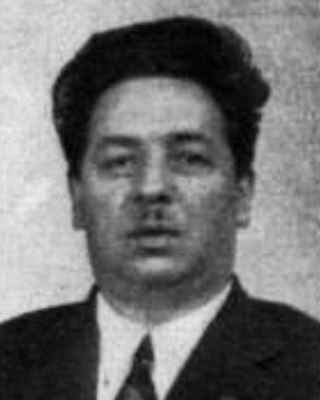
Hugo Gräf was a German Communist politician.

Willy Leow was a German communist politician and activist.

International Communists of Germany was a Communist political grouping founded in November 1918 during the German Revolution. The small party was, together with the better known Spartacist League, one of the constituent organizations that joined to form the Communist Party of Germany in 1918.

The Three Arrows is a social democratic political symbol associated with the Social Democratic Party of Germany (SPD), used in the late history of the Weimar Republic. First conceived for the SPD-dominated Iron Front as a symbol of the social democratic resistance against Nazism in 1932, it became an official symbol of the Party during the November 1932 German federal election, representing their opposition towards monarchism, Nazism, and communism.

Rosa Lindemann was a German communist and member of the German resistance to Nazism. She was born in Spandau, her family moved to Moabit when she was a child. She married Karl Lindemann in 1895, both joined the Social Democratic Party of Germany (SPD) in 1909. She later moved to the USPD, then the Communist Party of Germany (KPD) in 1920. She was elected to the city council and an active member of the Workers International Relief and Rote Hilfe.

Bruno Baum was a German official for the Communist Party of Germany and Socialist Unity Party of Germany. He also served as a resistance fighter during World War II.
Ella Ehlers was a German Kindergarten teacher. Through her work, in 1926 she met Adolf Ehlers (1898–1978), a political activist who at around the same time was readmitted to the Communist Party. She became his secretary and then, in 1928, his wife. Ella Schimpf had grown up in a heavily politicised family, and she now participated energetically with her husband in the increasingly polarised politics of the time. After 1933 she engaged in dangerous anti-government resistance, but she nevertheless survived the twelve Hitler years.

















